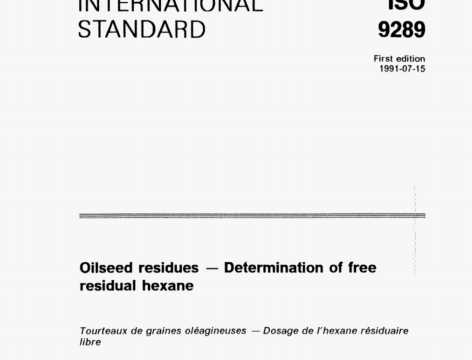ISO 9289 pdf download – oilseed residues — Determination of free residual hexane.
Usual laboratory apparatus and, in particular, the following
6.1 Gas chromatograph, with flame ionization detector and an integrator and/or recorder, equipped with either
a) a packed steel column approxImately 2 m long and of internal diameter approximately 3,2 mm, packed with an acid-washed diatomaceous earth support of particle size 150 iim to 180 lim (Chromosorb P NAW 60/80 mesh’ is suitable), and coated with 10 % squalane or methylpolysiloxane (SE 30” is suitable), or
b) a capillary column, approximately 30 m long and of 0,3 mm Internal diameter, coated with methylpolysiloxane (SE 301) is suitable) having a film thickness of 0,2 rim.
The Injector and detector temperature shall be set at approximately 120 °C and the oven temperature at approximately 40 °C. The carrier gas pressure shall be set at approximately 0,3 bar (30 kPa).
If a capillary column is used, the apparatus shall have a 1/100 split injection system.
NOTE 3 For analyses in series, it is recommended to use a gas chromatograph having an automatic sample injection system, combined with a heating bath.
6.2 Heating bath, fitted with a rack to hold the flasks (6.4), capable of being set at 80 °C ± 2 °C and of maintaining the set temperature constant to ± 01 °C.
NOTE 4 For continuous use, glycerol is recommended as the heating liquid.
6.3 Gas syringe, of I ml capacity.
6.4 Septum flasks, of 20 ml ± 2 % capacity.
6.5 Septa, inert to hexane, of approximately 3 mm thickness, made of a material such as nitrile rubber (e.g. Perbunan”), or butyl rubber with a polytetrafluoroethylene or polychloroprene seam (e.g. Neoprene”).
Ensure that the septa used will produce a hermetic seal after crimping.
ISO 9289 pdf download – oilseed residues — Determination of free residual hexane
